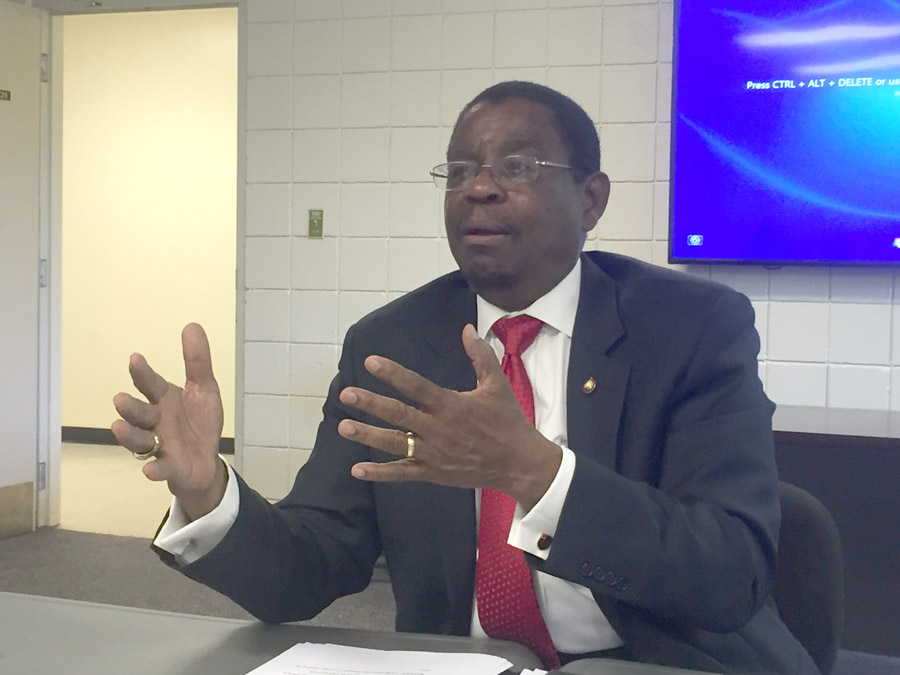Orangeburg Massacre beginnings in 1619, Tisdale says
By: Panther staff
Feb 06, 2018

Dr. Henry N. Tisdale, Claflin president, was a student in Orangeburg during the 1960s. Here he speaks to journalism students on Jan. 30. (Panther photo)
“The pot boiled over” in 1968 but the makings of the Orangeburg Massacre began in 1619, Claflin President Dr. Henry N. Tisdale said.
Addressing journalism students in a Jan. 30 session devoted to the 50th anniversary of the Orangeburg Massacre on Feb. 8, Tisdale first looked back in time.
“The making of the Orangeburg Massacre was when the first African-Americans were brought to America,” Tisdale said.
“The pot started heating up in 1869 when a group of blacks, whites, church leaders, educators and freemen from the North decided to establish a university in Orangeburg that was so different from the status quo and the law of the land,” Tisdale said.
The founding of then-Claflin College created the need for change, Tisdale said. But during that time, a school that gave educational access to recently freed African-Americans was not wanted.
“This was very disruptive for Orangeburg,” Tisdale said.
Fast forward to the 1950s and watershed cases such as Briggs vs. Elliott in Clarendon County, which became part of the landmark Brown vs. Board of Education of Topeka that outlawed segregated public schools.
But the law did not have immediate impact in South Carolina. “Nothing was happening,” Tisdale said.
As a key place in the civil rights movement, Orangeburg was the scene for petitions seeking desegregation in 1957.
Blinzy L. Gore, author of the Claflin history titled “On A Hilltop High,” called the petition the beginning of a struggle for social change that culminated in the gunfire of the Orangeburg Massacre, the 1968 incident in which state troopers killed three students and 28 others at then-South Carolina State College amid a protest over a segregated bowling alley.
Claflin played a key role in change, Tisdale said. Anything related to petitioning was prohibited on the S.C. State campus because it was a public school. Therefore, everyone came to the Claflin campus to come together and plan.
“Claflin was the perfect place,” said Tisdale, a Williamsburg County native and 1965 Claflin graduate who as a student was part of the protest movement here.
“I arrived at the height of the civil rights movement,” Tisdale said. “We were fighting for equality and justice.”
Both white and black teachers participated in the movement, Tisdale said. “Students had to be cautious when they left both Claflin and S.C. State. We had to be careful how we ventured out.”
Tisdale said at some times, so many protesting students would be in jail that classes were canceled because of the number arrested.
Orangeburg was the perfect place for the movement to flourish, Tisdale said. “We had great leadership from students.”
And things were happening:
1963 – Martin Luther King Jr.’s March on Washington.
1964 – Passage of the Civil Rights Act.
1965 – MLK visits Claflin.
Then came 1968 when there remained vestiges of segregation – such as the private bowling alley in Orangeburg.
“1968 was a special year throughout the country,” Tisdale said. “The nation itself was in turmoil.”
“Students believed they were fighting for equal rights,” Tisdale said.
And on the night of Feb. 8, 1968, after days of protests amid a “really tense” atmosphere, state patrolmen fired on students at the S.C. State campus.
Claflin students were among the wounded, which number more than the listed 28, Tisdale said. “It’s always a partial list” as some did not report injuries.
“It did not end on Feb. 8,” Tisdale said. “There are so many who feel no justice was done.”
Even newspaper accounts of the time blamed the victims for what happened, Tisdale said. Black lives did not matter.
“Where’s the justice?” That questions remains today, the Claflin president said.
“There should be a full an independent investigation and let the chips fall where they may,” Tisdale said of the Orangeburg Massacre.
This story is compiled from reports by Jasminn Dow, Jelah Anderson, Da’Teisha Graham and Alexis Bookman.